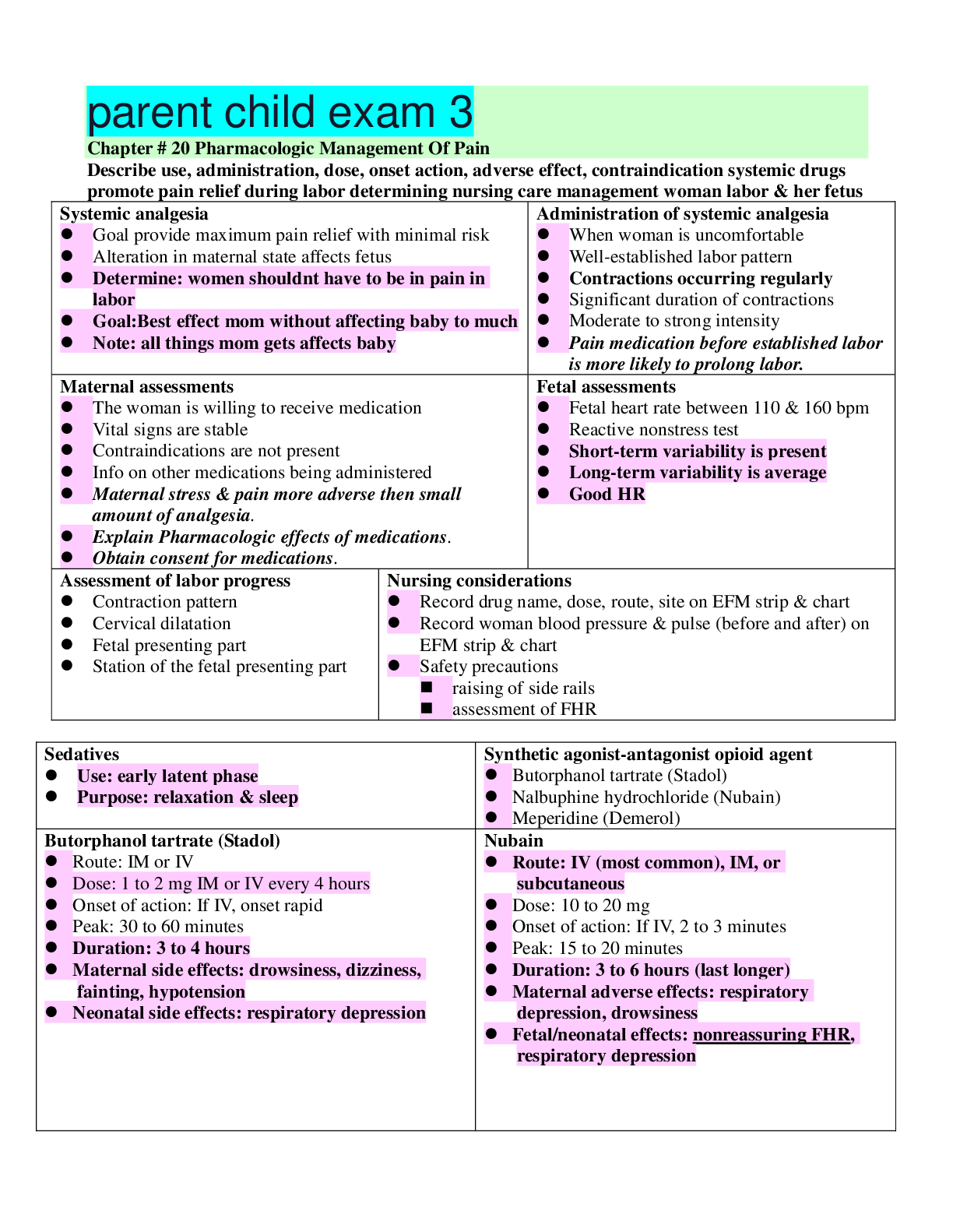*NURSING > STUDY GUIDE > NSG 6430 Womens health exam study guide with complete solution(A+ work);South University (All)
NSG 6430 Womens health exam study guide with complete solution(A+ work);South University
Document Content and Description Below
Abnormal uterine bleeding (AUB) has multiple causes. When a woman presents and reports menstrual irregularity with amenorrhea, which is the most common cause of amenorrhea? Ectopic pregnancy Adeno... myosis Coagulopathy Anovulation • The Tanner scale of sexual maturity rating allows for accurate classification of physical pubertal maturation. During the examination of your patient, you notice that the pubic hair is increased in quantity, is darker, and is present in the typical female triangle but in a smaller quantity. Which of the following Tanner stages does this description meet? Tanner stage I Tanner stage II Tanner stage III Tanner stage IV • A twenty-five-year-old patient presents with urinary frequency and urgency. These symptoms have been occurring for three days without fever. A patient with interstitial cystitis would most likely describe their symptoms as _______. urinary urgency and frequency in the morning and at night pain with urination with scant bleeding terminal dysuria urinary urgency only • The most common cause of chronic pelvic pain for women in the prime of their reproductive years is PID Fibroids CORRECT Endometriosis Endometritis • A fifty-two-year-old female patient comes in for her annual well-woman examination. Her LMP was fourteen months ago without any breakthrough bleeding. She has also developed some hirsutism. You would document this as __. secondary amenorrhea menopause perimenopause polycystic ovary syndrome (PCOS) • Polycystic ovaries predispose women to a higher incidence of: Adrenal tumors Ovarian cancer Endometrial cancer Endometriosis • A definitive diagnosis of endometriosis cannot be made until which of these is completed? CT scan Transvaginal ultrasound Exploratory laparoscopy MRI • After a thorough history, you note that Marie resides in a community with very high risk factors. These include poverty, violence, and lack of recreational facilities. She tells you that she “hangs out” at a convenience store near the apartment complex she lives at with her mother. “All the group hangs there,” she reports proudly. She shares that she has been menstruating for two years now although she has irregular cycles. She also lets you know that she has had coitus only one time and that he “pulled out.” She does not want to get pregnant, and this is why she is here today. What is your management plan for Marie today? Student Answer: CORRECT You will assess all predisposing factors that lead to premarital sex and the negative consequences, tell Marie to be careful, and prescribe birth-control pills. CORRECT One by one, you will plan to carefully address the risks (red flags) in Marie’s history. Your goal will be to clarify and address misconceptions, as well as share valuable sex education in a sensitive, nonjudgmental way. You will let her know you are her advocate and are very protective of her health. Without preaching, you want her to be aware of the negative possibilities of premarital, unprotected sexual activities. You will also share a clear understanding of the risk of STIs with Marie. CORRECT After processing all of the history Marie has shared, you will write a referral for psychiatric evaluation and tell her she needs ongoing counseling for her behavior at such a young age and she likely needs to learn to cope within her environment (home and community). CORRECT Your goal is to include healthy sexual-health decision making, including decisions regarding abstinence, birthcontrol efficacy and choice, and condom use. Depending on the need, you may include a referral to an effective program for teens (for example, a program that deals with STI prevention and or a family-based intervention program if available). • A well-woman visit for an adolescent should include which of the following? A general health history and physical examination, including a breast examination, pelvic with Pap smear, screening tests, counseling, immunizations, risk factors, and patient concerns A general health history focusing on reproductive and sexual health concerns (menses, gynecologic, and pregnancy related) and psychosocial (family related, peer related, emotional, and physical as well as related to abuse, drug use, and alcohol use) concerns Physical exam, screening tests, and immunizations as indicated by the health history and gynecologic considerations for an external-only inspection of the genitalia CORRECT Both b and c • A seventeen-year-old presents with an appointment for unilateral breast tenderness and swelling. Which of the following would be the most likely etiology for this problem? Breast cancer Mastitis Fibrocystic breast Fibroadenoma • You are completing a pelvic exam on thirty-two-year-old Nancy. You detect a left adnexal mass on the bimanual exam. With an adnexal mass, the practitioner must always suspect ________ until proven otherwise. Pelvic inflammatory disease (PID) Malignancy Pregnancy Polycystic ovary disease X • Majority of urinary tract infections do not require consultation or a referral to a specialist and are routinely treated in primary care practices. Which of the following scenarios would indicate that a consultation or referral is indicated? The presence of secondary sexually transmitted illness A patient with two episodes occurring in one year Patients that remain symptomatic after three days of treatment Patients that show urine human chorionic gonadotropin (HCG) positive • . Long-acting progestins may be used in patients as a contraceptive method. One of the longacting progestins is Depo-Provera. Which of the following best describes the mechanism of action of long-acting progestins in contraception? Decrease in cervical mucus production and thinning of the circle os Thickening of cervical mucus and suppression of gonadotropin levels Increased gonadotropin levels and thinning of the circle os Anovulation caused by increased gonadotropin levels • Iris is a thirty-two-year-old married woman with three children. She comes in for information on using the copper T intrauterine device (IUD) for contraception. Which of the following would be a contraindication to using this appliance? Prior ectopic pregnancy • TeYou are counseling an eleven-year-old girl, Amanda, and her mother about human papillomavirus vaccine (HPV), Gardasil. Amanda is Tanner stage IV at this visit. In counseling this family, you tell them that HPV vaccine ______. is a series of three doses, six months apart will protect Amanda from all strains of HPV can cause seizures in some children is not indicated in her age group as she is not yet sexually active • Urinary tract infections are commonly seen in primary care. A twenty-five-year-old female presents with a new onset of dysuria and suprapubic pain for the last twenty-four hours. The examination reveals only mild tenderness without any peritoneal signs on the lower abdomen. A urinalysis reveals the presence of WBCs. The urine is sent for a culture and sensitivity. In addition to Escherichia coli one might typically expect to see the presence of which bacterium? Klebsiella Staphylococcus aureus Staphylococcus saprophyticus Pseudomonas • Which of the following conditions is not an absolute contraindication to estrogen-containing contraception? Migraine headaches Hypercoagulable state Thromboembolism History of coronary artery diseaseDefinition • Natasha is an eleven-year-old girl brought to your office for an annual well-child visit. When discussing the onset of puberty with Natasha and her mother, you would emphasize which of the following? Breast buds develop before pubic hair. Breast development delayed beyond twelve years of age may be considered pathological. The average age of menarche is nine years. It usually takes about three and half years to go from breast buds to menarche. • A woman is experiencing a milky white nipple discharge. Galactorrhea is usually a finding with which other diagnosis? Fibrocystic breast disease Mastalgia Hyperprolactinemia Breast cancer • You are completing a pelvic exam on thirty-two-year-old Nancy. You detect a left adnexal mass on the bimanual exam. With an adnexal mass, the practitioner must always suspect ________ until proven otherwise. Pelvic inflammatory disease (PID) Malignancy Pregnancy Polycystic ovary disease X A nurse practitioner is educating a patient who has just been diagnosed with polycystic ovary syndrome (PCOS). She needs to be aware that PCOS is associated with which of the following clinical manifestations? Excessive menstrual flow Dry, flaking skin Obesity Hair loss Anticholinergic medications are a type of treatment for which type of incontinence? Urge incontinence sixty-five-year-old obese female with type II diabetes mellitus presents to your office with a complaint of vaginal itching and burning for two weeks. She has not been sexually active for five years. She has tried douching with an OTC cream with no relief. On physical examination, the vulva is deep red with some thick white adherent material. Which of the following conditions would be the most likely cause of her symptoms? Herpes simplex Lichen planus Atrophic vaginitis Fungal infection One important principle of antiretroviral therapy is Response to drug therapy is monitored by HIV RNA levels. A thirty-two-year-old woman presents to your practice with a chief complaint of postcoital bleeding. Which of the following would not be included in the initial assessment of this patient? pap Question 100. Question : The World Health Organization (WHO) has determined absolute contraindications to estrogen containing contraceptives. Which of the following is not an absolute contraindication? Student Answer: History of cerebrovascular accident (CVA) CORRECT Greater than age of thirty-five years Hypertension with vascular disease INCORRECT Active viral hepatitis A twenty-five-year-old patient presents with irregular bleeding after being on oral contraceptives for six months. It is important to rule out which of the following? Chlamydial cervicitis Uterine fibroids Endometriosis Anovulation patient is completing a diary of her premenstrual syndrome (PMS) symptoms. The nurse practitioner understands that PMS occurs with greatest frequency and severity in the luteal phase A nurse practitioner instructor is reviewing the anatomy of the external genitalia. At the opening of the vagina are the Bartholin's glands. Which of the following describes the function of these glands? Student Answer: Hormone production for ovulation CORRECT Production of alkaline secretion for sperm viability Development of mucous plug for pregnancy Maintenance of vaginal pH to prevent vaginitis Bartholin's glands There are several phases to the menstrual cycle. What phase begins with menses cessation and ends with ovulation? Student Answer: Ovulatory phase CORRECT Follicular phase Proliferative phase INCORRECT Luteal phase The most common cause of pelvic pain can be noted as endometriosis. But you also know that the most acute causes of pelvic pain are probably Salpingo-oophoritis (fallopian tube/ovary) secondary to PID A nurse practitioner is participating in a sexual education class for children in middle school. Which of the following is important to review as a nonprotective factor against repeat adolescent pregnancy? Student Answer: Use of effective contraception Participation in specialized adolescent parent program CORRECT Continued sexual relationship with the same partner INCORRECT Continued school attendance A teenage patient presents with amenorrhea and normal secondary sex characteristics. A progesterone challenge is ordered. The purpose is to determine the presence of ______. Student Answer: prolactin INCORRECT luteinizing hormone (LH) CORRECT endogenous estrogen follicle-stimulating hormone (FSH) A thirty-nine-year-old female has just completed a course of Amoxicillin for the treatment of streptococcal pharyngitis. Her LMP was two weeks ago and reports that it was normal for her. On physical examination, there is some erythema of the external genitalia with a small amount of white discharge. The microscopic wet prep examination reveals few clue cells but an abundance of budding hyphae. There are no WBCs present. Considering the differential diagnoses and results of the microscopic examination, which of the following would be the most appropriate treatment? Student Answer: Metronidazole 500 mg BID for seven days OTC hydrocortisone 1% cream TID CORRECT Fluconazole tablets 150 mg as a onetime dose Erythromycin 500 mg TID for ten days Which of the following is true regarding education of a forty-two-year-old woman diagnosed with uterine myoma? Student Answer: Myomas usually does not resolve with menopause. CORRECT Myomas will decrease with the withdrawal of estrogen. Hysterectomy is the treatment of choice. Myomas are never responsible for uterine bleeding. A nurse practitioner is completing a social and medical history of a patient. Which of the following characteristics places her at risk for early menopause? Student Answer: Overweight (BMI 26-29) CORRECT Current smoker INCORRECT Early menarche Nulliparity You are performing an annual well visit on a prepubescent female. Which of the following hormonal changes best describes the fluctuations during this time? Student Answer: A decrease in adrenal cortex androgens INCORRECT The initiation of secretion of follicle-stimulating hormone (FSH) CORRECT An increase of adrenal cortex androgens between six and eight years of age Elevation of estrogen levels at eight years of age A twenty-one-year-old patient presents with symptoms of lower urinary tract infection, including dysuria, frequency, and urgency. The urinalysis reveals the presence of leukocytes but is negative for nitrates. This most likely represents ______. Student Answer: vaginitis CORRECT specimen contamination sexually transmitted disease INCORRECT interstitial cystitis A patient has a prescription that was written for birth control pills that now has progestin added to the estrogen therapy. What would this intervention decrease the risk of? Student Answer: Fibrocystic breast disease Amenorrhea CORRECT Endometrial cancer Osteoarthritis A nurse practitioner is reviewing the chart of a woman who has findings consistent with polycystic ovary syndrome (PCOS).The diagnostic criteria for PCOS include all of the following except: Student Answer: irregular menstrual cycles hyperandrogenism infertility CORRECT male pattern baldness Breast tissue is composed of glandular, fibrous, and fatty tissue and a complex lymphatic system. Where does lymph from the medial cutaneous area of the breast flow? Student Answer: Axillary nodes CORRECT Opposite breast Mammary nodes Infraclavicular nodes A thirty-three-year-old woman presents to your clinic complaining of a dark brown, watery vaginal discharge and postcoital bleeding. There is a strong history of multiple unprotected sexual encounters. Which of the following findings on examination would be suspicious for cervical cancer? Student Answer: INCORRECT Ulcerated lesion on the cervical os A soft, pink cervix with no ulcerations An anteverted cervix CORRECT A very firm, easily friable cervix A fifteen-year-old patient who presents with symptoms consistent with premenstrual syndrome (PMS) is concerned that she may have ovarian cancer. Your best advice to this patient is that PMS is typically caused by which of the following? Student Answer: Polycystic ovarian disease Pituitary tumor CORRECT Genetic, psychosocial, and hormonal fluctuations Psychosocial issues and sleep disturbance It is known that a woman who is menopausal has an increased risk of heart disease. Which of the following lipid changes occur with estrogen withdrawal in menopause? Student Answer: Decrease in HDL, LDL, and triglycerides Decrease in HDL, LDL, and increase in triglycerides Increase in HDL with a decrease in LDL and triglycerides CORRECT Decrease in HDL with an increase in LDL and triglycerides Which of the following is an approved treatment for premenstrual dysphoric disorder (PMDD)? Student Answer: Amitriptyline (Elavil) Spironolactone (Aldactone) CORRECT Drospirenone/ethinyl estradiol/levomefolate calcium (Beyaz) Conjugated estrogen (Premarin) A patient has symptoms consistent with Chlamydia. Which laboratory test would aid in the diagnosis? Student Answer: Detecting the presence of inflammatory cells on a Pap smear INCORRECT Tissue examination using direct fluorescent antibody CORRECT Culture and sensitivity Wet prep with potassium hydroxide (KOH) assessing for positive “whiff” test A nurse practitioner is counseling a woman with fibrocystic changes in the breast. Which of the following is not caused by this change? Student Answer: Breast pain CORRECT An increased risk of breast cancer Hard masses Painless lumps A patient is coming to the clinic for a follow-up of some diagnostic testing that she had done. When you review the chart, you find that she now has findings consistent with a diagnosis of polycystic ovary syndrome (PCOS).You recall that PCOS is characterized by which of the following? Student Answer: Menorrhagia CORRECT Infertility Menometrorrhagia Hypoadrogenism A twenty-five-year-old pregnant client presents with a complaint of headaches that are confined to the base of the head as well as the upper neck and feels “tight” in nature. She denies visual changes, photophobia, or nausea. The most likely diagnosis is which type of headache? Student Answer: Common migraine Cluster CORRECT Muscular tension Sinus A nurse practitioner is caring for a woman with primary and secondary amenorrhea. The pelvic exam was normal. Which of the following may be the cause if etiology originates in the hypothalamus? Student Answer: CORRECT Sheehan's syndrome Ovarian failure INCORRECT Thyroid dysfunction Asherman's syndrome You are examining a twenty-nine-year-old female with a three day history of dysuria and urinary frequency. On examination, the patient has mild abdominal pain with palpation in the umbilical area without rebound tenderness. Her test for cerebrovascular accident (CVA) tenderness is negative. This most likely represents which of the following? Student Answer: Pyelonephritis INCORRECT Interstitial cystitis Ectopic pregnancy CORRECT Ascending urinary tract infection A thirty-five-year-old female presents with perimenopausal symptoms. You recall that this may begin during which age group? Student Answer: INCORRECT Forty-five to fifty years CORRECT Thirty-five to forty years Fifty to fifty-five years Thirty to thirty-five years Points Received: A woman has been prescribed Depo-Provera injections every three months for contraception. What would be the most likely side effect that she would need to be educated about? Student Answer: CORRECT Abnormal uterine bleeding Dysmenorrhea Nausea INCORRECT Abdominal pain A woman has been prescribed Depo-Provera injections every three months for contraception. What would be the most likely side effect that she would need to be educated about? Student Answer: CORRECT Abnormal uterine bleeding Dysmenorrhea Nausea INCORRECT Abdominal pain A twenty-four-year-old female presents to the practice with a painless 2 cm, lobular mass in the right breast that is freely mobile and firm. This has been noted on self-breast examination, and she reports it has been unchanged for the past three months. The best course of action by the nurse practitioner would be to __________. Student Answer: CORRECT order a mammogram referral for surgical excision continue to observe the lesion and recheck in three months INCORRECT determine other risk factors such as family history of breast cancer Which of the following choices represents a disorder of the reproductive tract that causes pain, erythema, dyspareunia, and a perineal mass? Student Answer: Syphilis CORRECT Bartholin’s cyst Labial adhesion Herpes simplex type 2 Te A twenty-four-year-old female patient has been diagnosed with primary dysmenorrhea. Which of the following medications would be used as a first line to help control her symptoms? Student Answer: Antianxiety agents Progesterone-only contraception Oral steroids CORRECT Nonsteroidal anti-inflammatory drugsrm Changes in hormonal regulation during menopause result in the gradual cessation of menstruation. From which gland is Androstenedione secreted? Student Answer: Anterior pituitary Posterior pituitary Corpus Luteum CORRECT Adrenals A postmenopausal woman is concerned because she is having postcoital bleeding. Which of the following would be the most likely etiology? Student Answer: Cervical cancer Endometrial cancer CORRECT Atrophic vaginitis Polycystic ovary syndrome (PCOS) A fifty-five-year-old woman presents to the clinic for evaluation of a breast mass. Which of the following is not a typical presenting sign of breast cancer? Student Answer: Engorgement of one areola and nipple Dimpling of skin over breast Unilateral retraction and deviation of nipple CORRECT A 2 cm, rubbery, tender lesion A thirty-two-year-old patient comes in for a workup of infertility. During the history, the nurse practitioner suspects that the patient may be experiencing anovulatory cycles. In order to confirm ovulation, which of the following tests would be most appropriate to order? Student Answer: Endometrial biopsy CORRECT Basal body temperature INCORRECT Hysterosalpingogram Postcoital testing A seventeen-year-old female patient presents with amenorrhea for four months. She did experience menarche at the age of fifteen but had not had a menstrual cycle since. On physical examination, it is noted that she has normal secondary sexual characteristics. The nurse practitioner will consider a progesterone challenge to determine the presence of adequate __. Student Answer: CORRECT endogenous estrogen prolactin L-thyroxine INCORRECT follicle-stimulating hormone (FSH) A couple is presenting for a first trimester pregnancy exam. They are curious about the sex of the baby. You recall that the human embryo becomes bipotential at what week of gestation? Student Answer: INCORRECT Sixth Tenth Twelfth CORRECT Eighth A sixteen-year-old girl who comes to your office with a history of secondary amenorrhea. She experienced menarche at age ten, with regular cycles for two years. She has not menstruated now for four years. In your initial consideration of differential diagnoses, what is the most frequent etiology of this problem? Student Answer: CORRECT Eating disorder Pregnancy Anovulatory cycles INCORRECT Stress A forty-four-year-old woman with dysfunctional uterine bleeding (DUB) presents for treatment. Which of the following medications can be used for management of DUB? Student Answer: Ethinyl estradiol CORRECT Medroxyprogesterone Estrogen/progesterone combination Conjugated estrogen A patient is completing a diary of her premenstrual syndrome (PMS) symptoms. The nurse practitioner understands that PMS occurs with greatest frequency and severity in the ____. Student Answer: CORRECT late luteal phase midfollicular phase proliferative phase early luteal phase The onset and duration of puberty varies greatly from patient to patient and is also dependent upon race. Which of the following phrases can you expect to have the earlier onset of puberty in boys? Student Answer: CORRECT African American boys Native American boys Caucasian boys Hispanic boys Oral contraceptive agents may contain both progesterone and estrogen. The progesterone component of the oral contraceptive produces which the following effects? Student Answer: INCORRECT Decrease in luteinizing hormone (LH) CORRECT Cervical mucus production Increased levels of follicle-stimulating hormone (FSH) Thinning of the cervical os During pregnancy and lactation, the nutritional needs of the woman are increased with deficiencies resulting in harm to the woman or her baby. Neural tube defects are one of the most common birth defects. Deficiency of which nutrient is responsible for these conditions? Student Answer: Vitamin C CORRECT Folic acid INCORRECT Vitamin B12 Riboflavin During a community education program, a nurse practitioner is discussing the usefulness of mammography in the screening and detection of breast cancer. Which of the following statements is accurate? Student Answer: A mammogram should be done if there is any breast pain or nipple retraction. CORRECT All women over forty years of age should have a mammogram on an annual basis. A mammography should be done annually for all women of child-bearing age. Mammograms should be performed annually after the initial pregnancy, especially if the woman does not breast-feed. A twenty-five-year-old patient presents with irregular bleeding after being on oral contraceptives for six months. It is important to rule out which of the following? Student Answer: CORRECT Chlamydial cervicitis INCORRECT Uterine fibroids Endometriosis Anovulation The National Osteoporosis Foundation has screening guidelines for DEXA scans. Which of the following women would be most in need of bone mineral density testing? Student Answer: A sixty-year-old postmenopausal woman receiving hormone replacement therapy (HRT) A fifty-year-old woman who is having irregular menstrual cycles CORRECT A fifty-one-year-old woman with COPD on long-term corticosteroid therapy A forty-nine-year-old, obese Caucasian woman who smokes A patient asks why she needs a breast ultrasound when she already has had a mammogram. Which of the following would be the best response of the use? Student Answer: To locate small lesions prior to surgery As a screening test for breast cancer CORRECT To determine if a breast lesion is cystic or solid For definitive diagnosis of breast cancer A thirty-one-year-old female presents for contraceptive counseling following the birth of their first child. She is interested in using the diaphragm as her method of contraception. Which of the following statements is true regarding the use of this device? Student Answer: INCORRECT The device may be inserted up to twenty-four hours prior to intercourse. The device may be left in place for up to twelve hours. CORRECT The device may be inserted at any time up to six hours prior to intercourse. The device should be removed within one hour after intercourse. In reviewing cancer statistics, after breast cancer, what would you find to be the most common female genital malignancy? Student Answer: CORRECT Endometrial Ovarian Vulvovaginal INCORRECT Cervical A twenty-four-year-old female presents to the office with a complaint of vaginal itching in addition to thick mucoid discharge. She also has some mild urinary discomfort. A wet mount preparation using potassium hydroxide (KOH) reveals a negative whiff test and few clue cells. There were no trichomonads visualized but the WBCs were too numerous to count. Which of the following would be the most likely diagnosis in this patient? Student Answer: Bacterial vaginosis Herpes simplex CORRECT Chlamydia Cystitis with cervicitis A woman is concerned that she may develop breast cancer. Which of the following is not an associated risk factor for this? Student Answer: CORRECT Late menarche Family history Nulliparity INCORRECT Late menopause Breast masses are a common finding in adolescents and most typically are benign. Which of the following descriptions of a breast mass most likely represents a benign finding? Student Answer: CORRECT Bilateral, round, or oval firm mass Unilateral, round mass with hard consistency Bilateral, round, or oval for mass with dimpling of the nipple Multiple unilateral masses with hard consistency found in the axilla Which of the following statements best describe the difference between type I and type II bone loss in patients with osteoporosis? Student Answer: Type II bone loss involves the trabecular compartment Type II bone loss results from loss of ovarian function Type I bone loss involves the cortical bone CORRECT Type I bone loss results from loss of ovarian function A thirty-two-year-old woman presents to your practice with a chief complaint of postcoital bleeding. Which of the following would not be included in the initial assessment of this patient? Student Answer: INCORRECT Papanicolaou smear CORRECT Uterine biopsy Pelvic ultrasound CBC with diff A nurse practitioner is performing a wet mount with potassium hydroxide (KOH) to assist with a diagnosis in a woman experiencing vaginal discharge. Which of the following would this confirm? Student Answer: Herpes simplex Trichomonas CORRECT Candidiasis INCORRECT Chlamydia A sixty-five-year-old obese female with type II diabetes mellitus presents to your office with a complaint of vaginal itching and burning for two weeks. She has not been sexually active for five years. She has tried douching with an OTC cream with no relief. On physical examination, the vulva is deep red with some thick white adherent material. Which of the following conditions would be the most likely cause of her symptoms? Student Answer: Herpes simplex Lichen planus INCORRECT Atrophic vaginitis CORRECT Fungal infection A nurse practitioner is educating a patient who has just been diagnosed with polycystic ovary syndrome (PCOS). She needs to be aware that PCOS is associated with which of the following clinical manifestations? Student Answer: Excessive menstrual flow Dry, flaking skin CORRECT Obesity Hair loss A twenty-eight-year-old female presents with breast tenderness, fatigue, abdominal bloating, fluid retention, and irritability one week prior to the onset of her menses. The nurse practitioner suspects the patient may have premenstrual syndrome (PMS). What is the most important information to obtain from this patient to make the determination? Student Answer: Severity of symptoms CORRECT Occurrence of symptoms in the menstrual cycle INCORRECT Frequency and number of symptoms over the past four months Presence or absence of depression or anxiety A woman is experiencing a milky white nipple discharge. Galactorrhea is usuall [Show More]
Last updated: 1 year ago
Preview 1 out of 41 pages

Buy this document to get the full access instantly
Instant Download Access after purchase
Add to cartInstant download
We Accept:

Reviews( 0 )
$12.00
Document information
Connected school, study & course
About the document
Uploaded On
Jan 12, 2021
Number of pages
41
Written in
Additional information
This document has been written for:
Uploaded
Jan 12, 2021
Downloads
0
Views
37

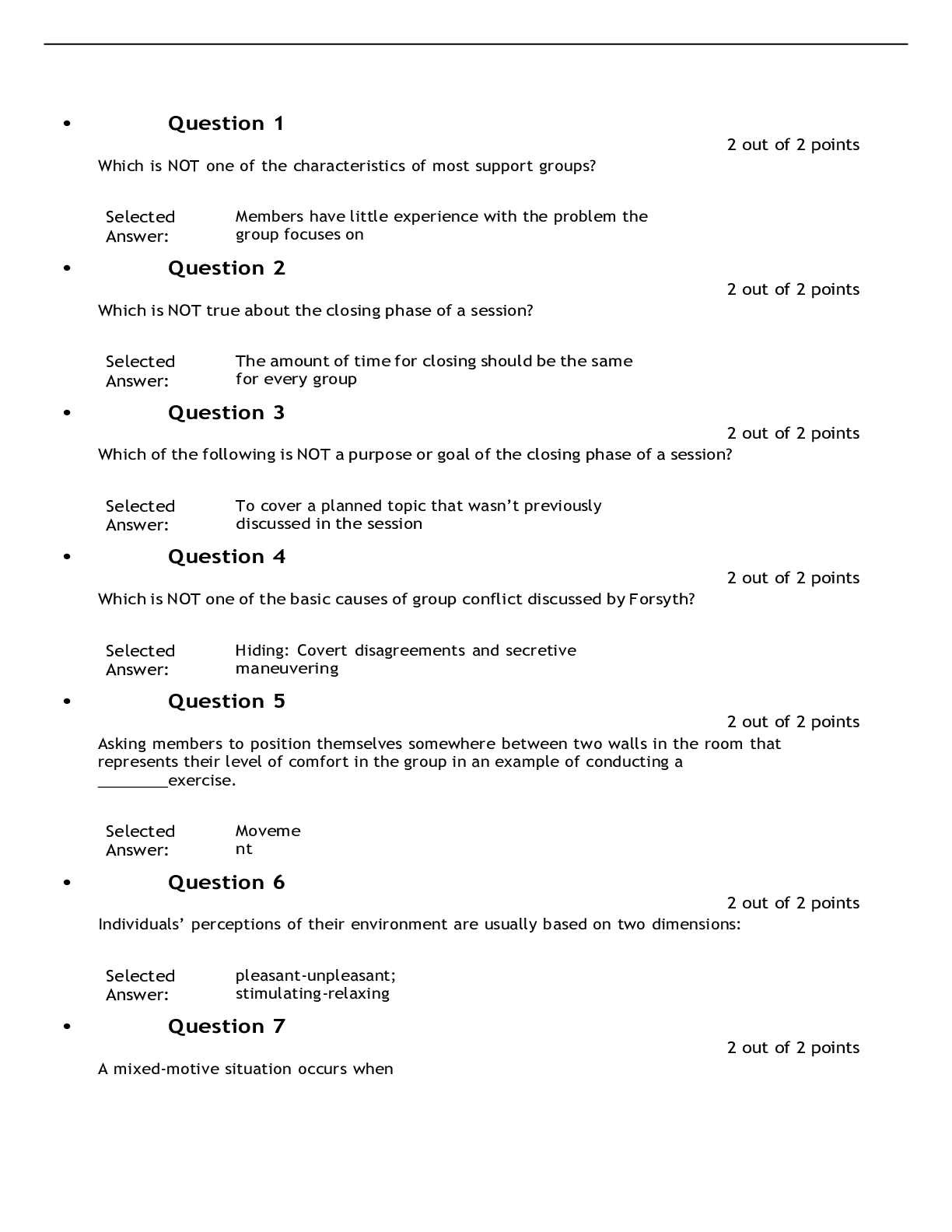

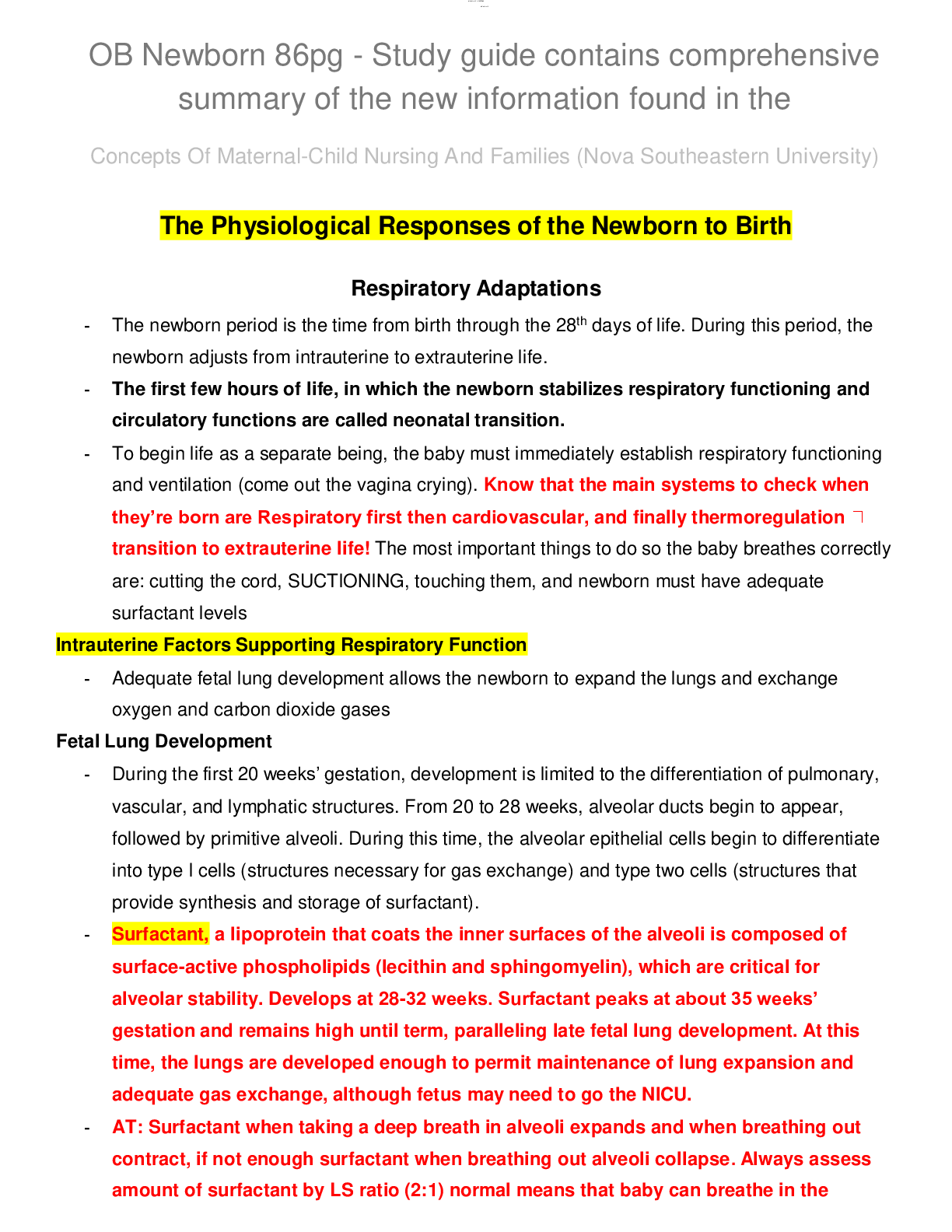
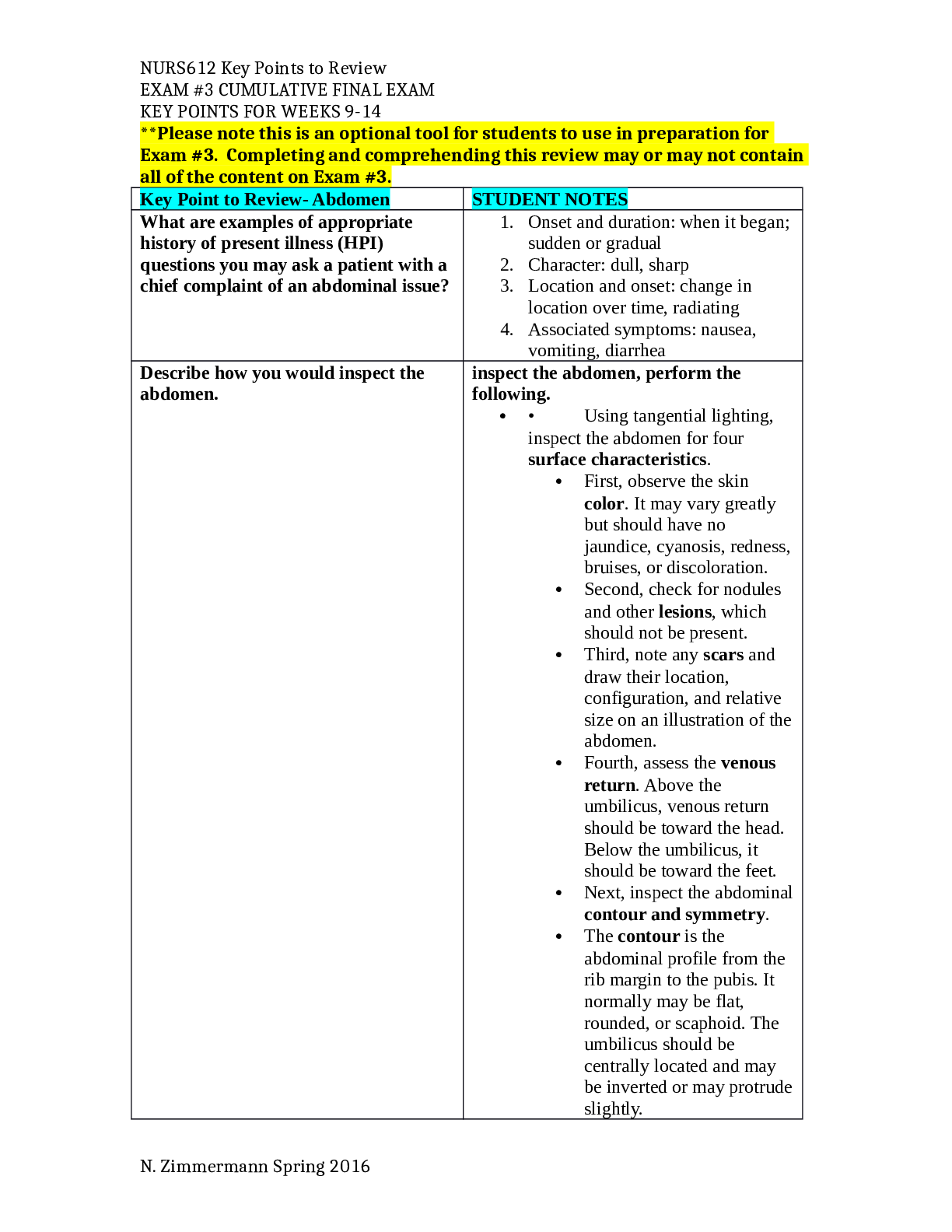


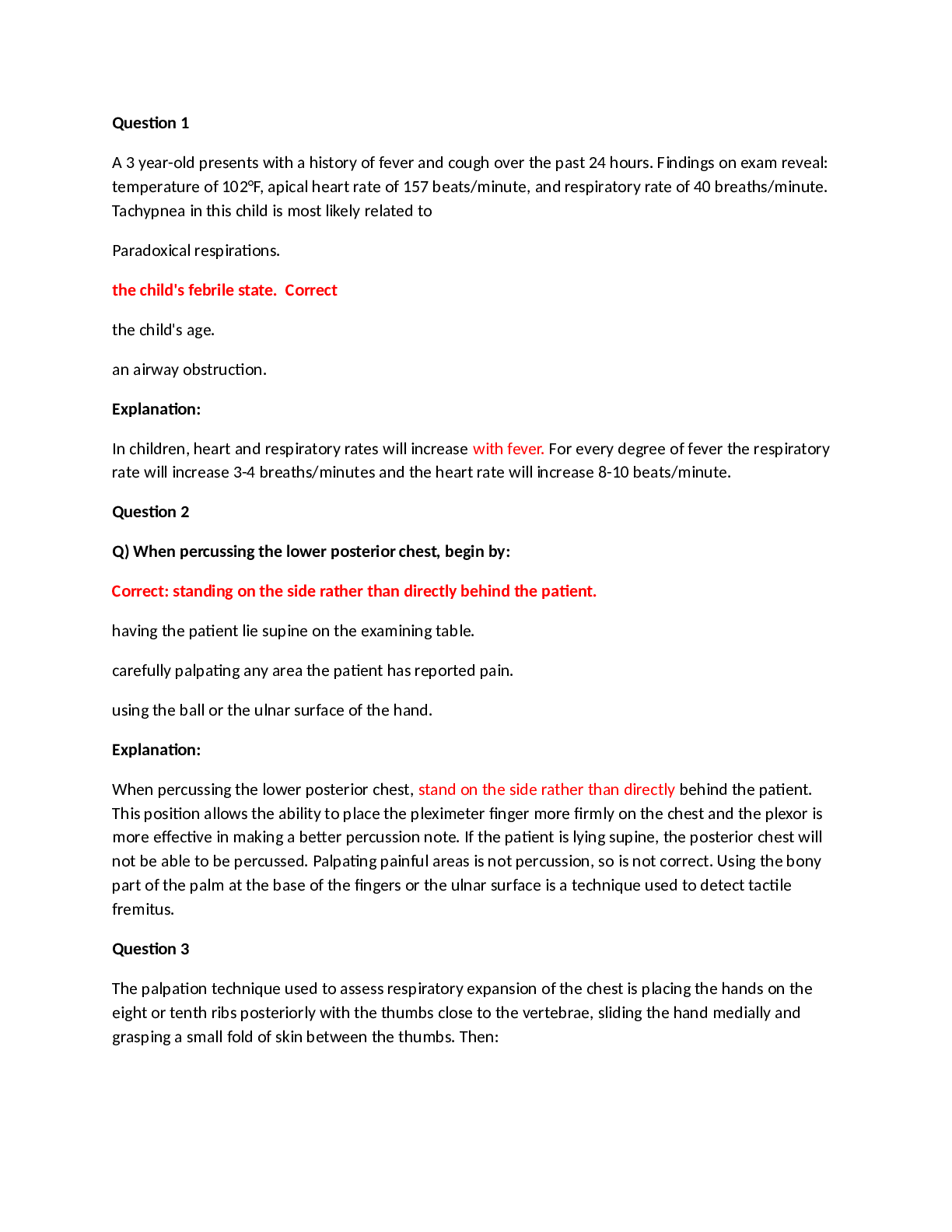

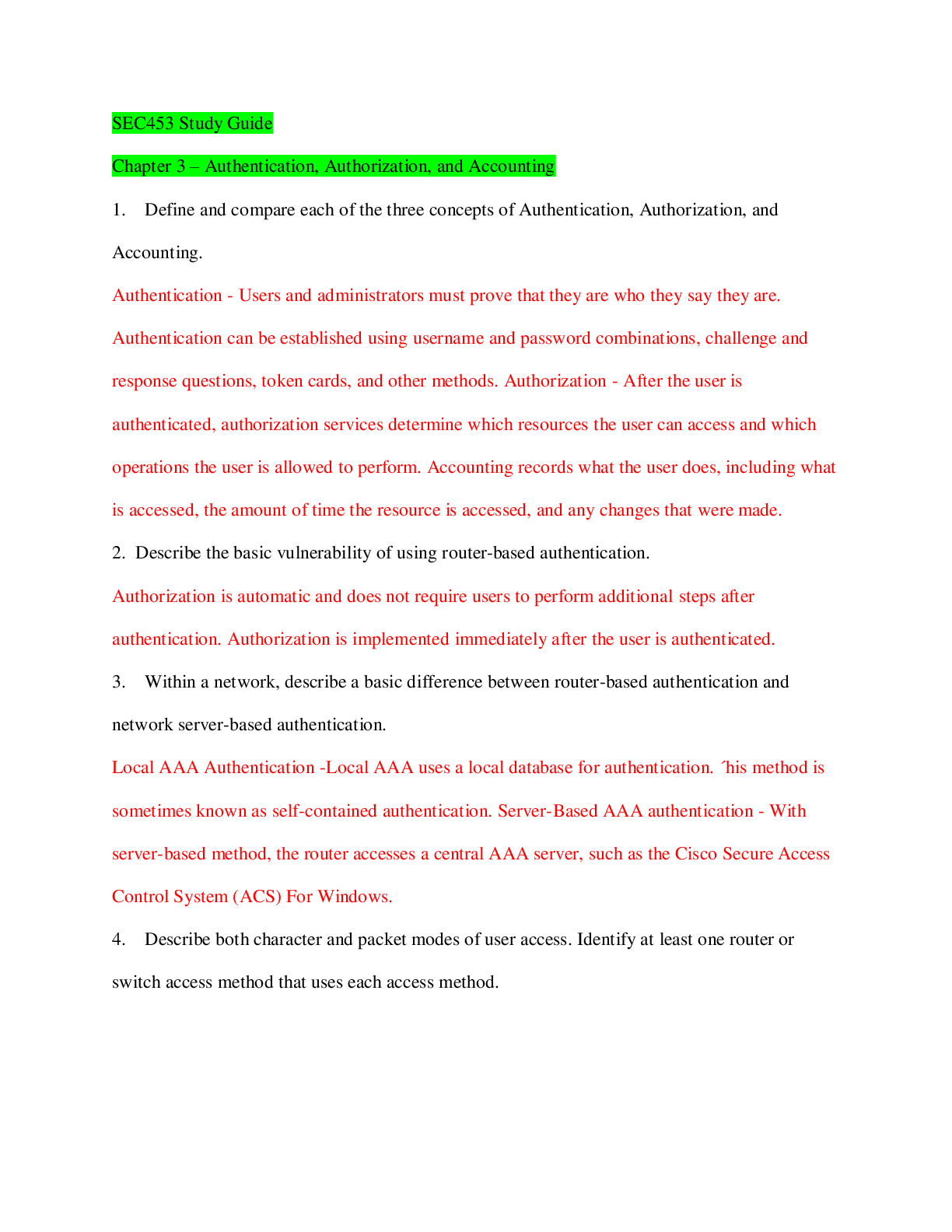

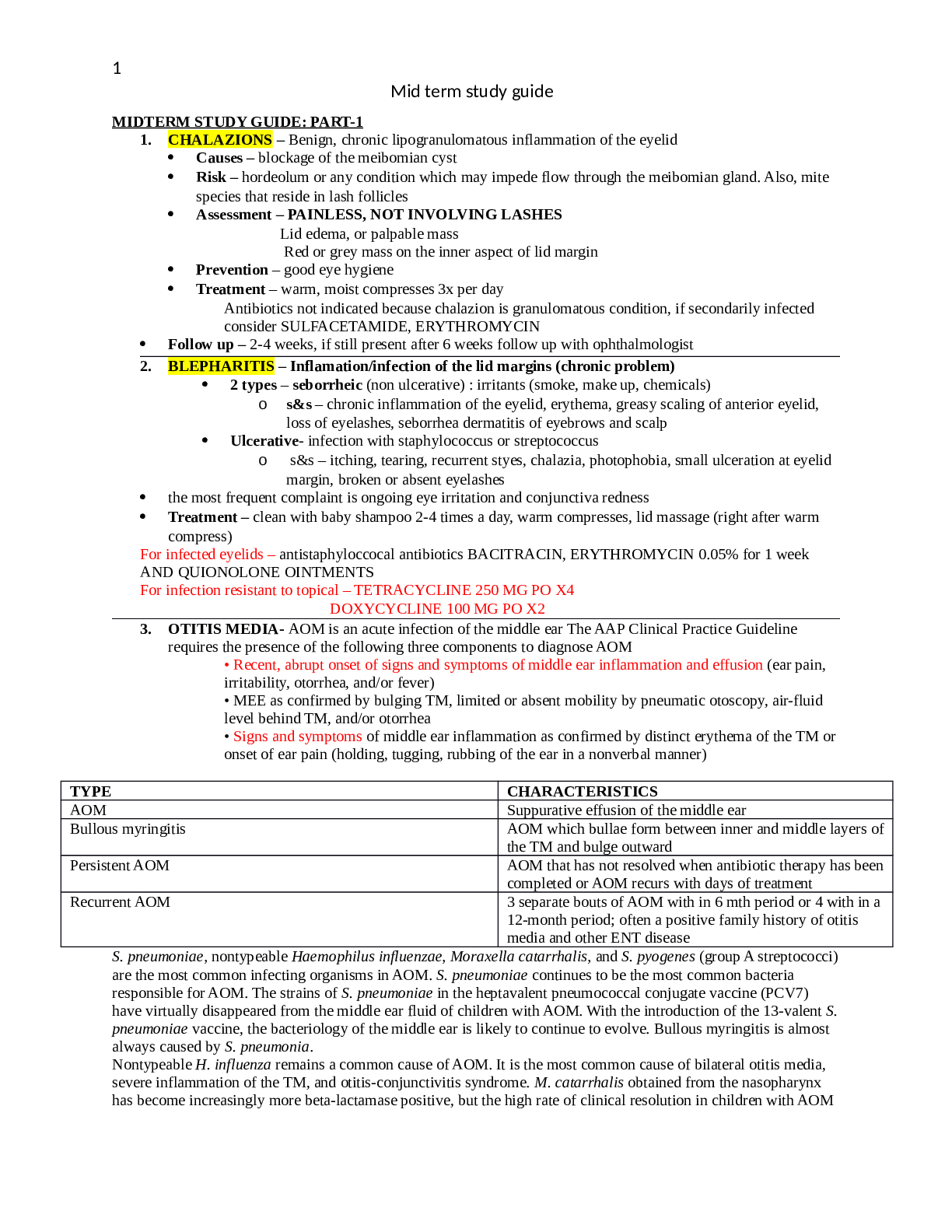
 (2).png)
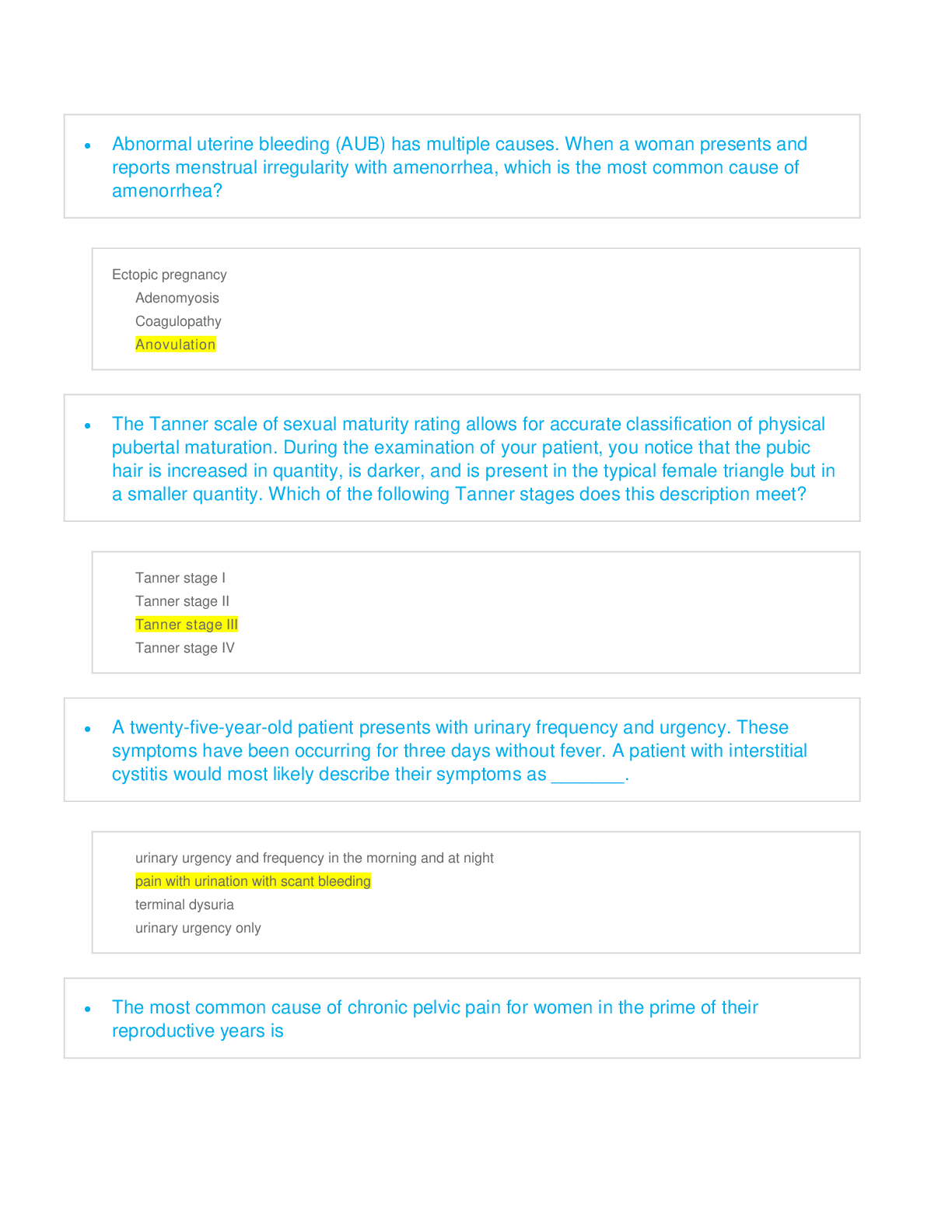
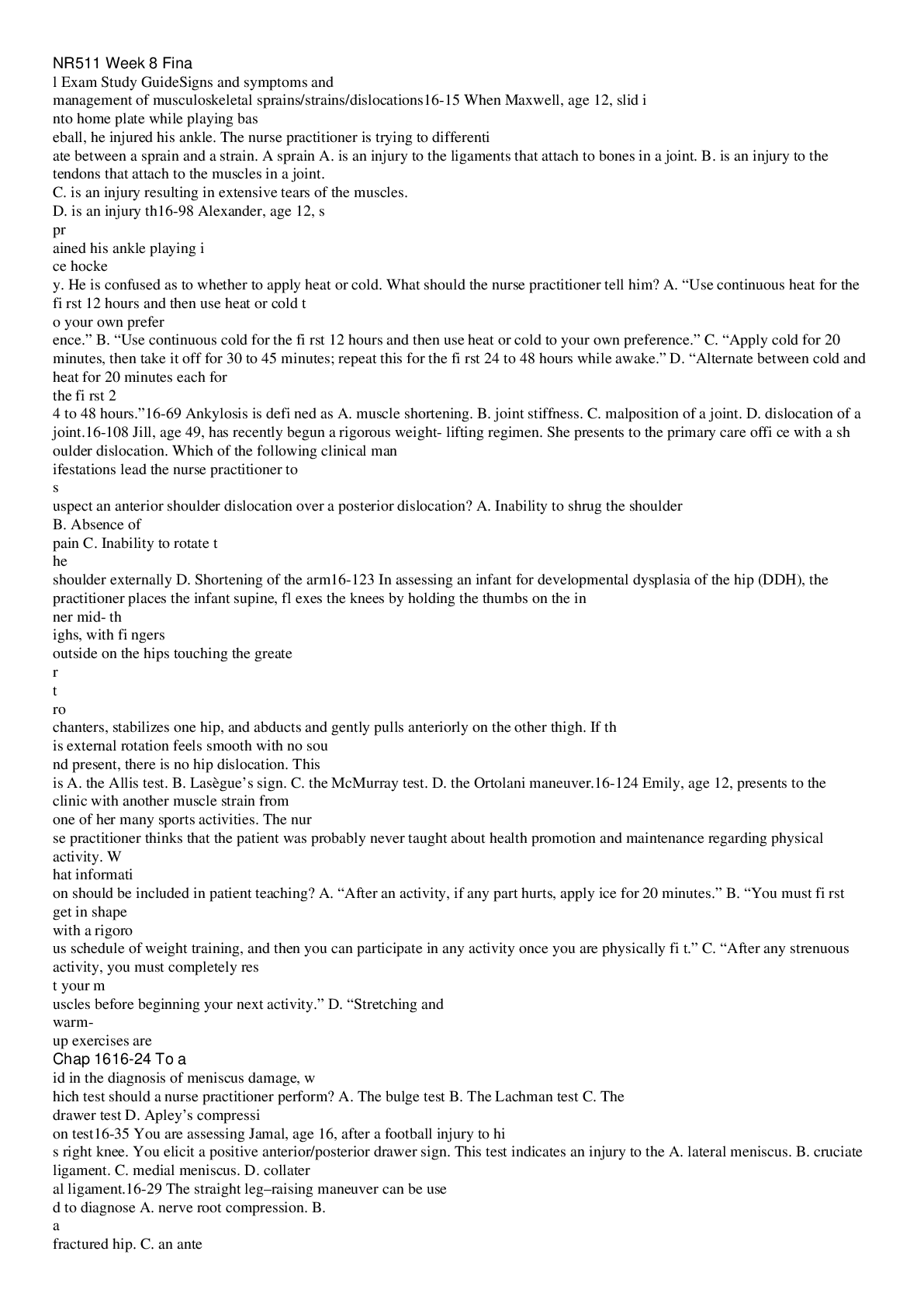
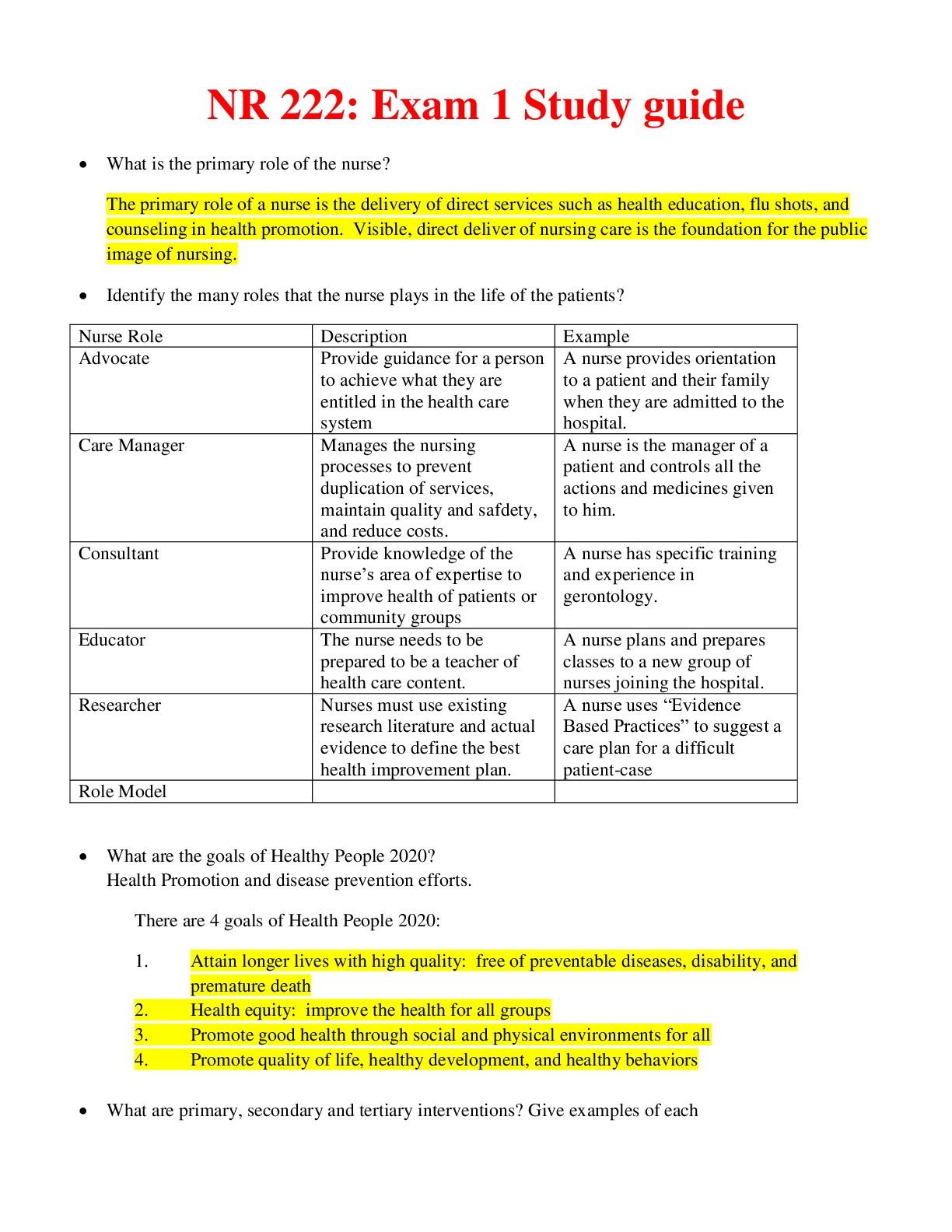
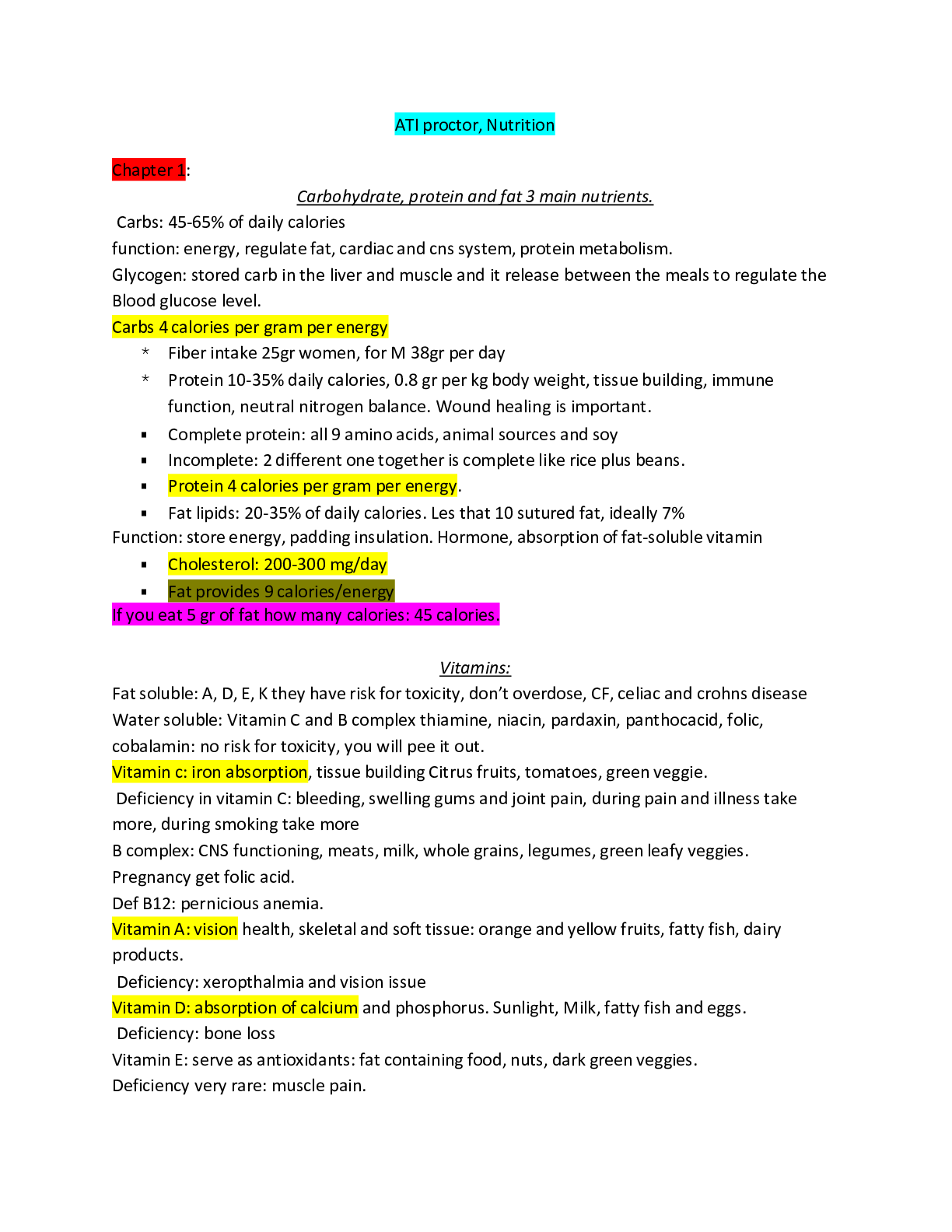
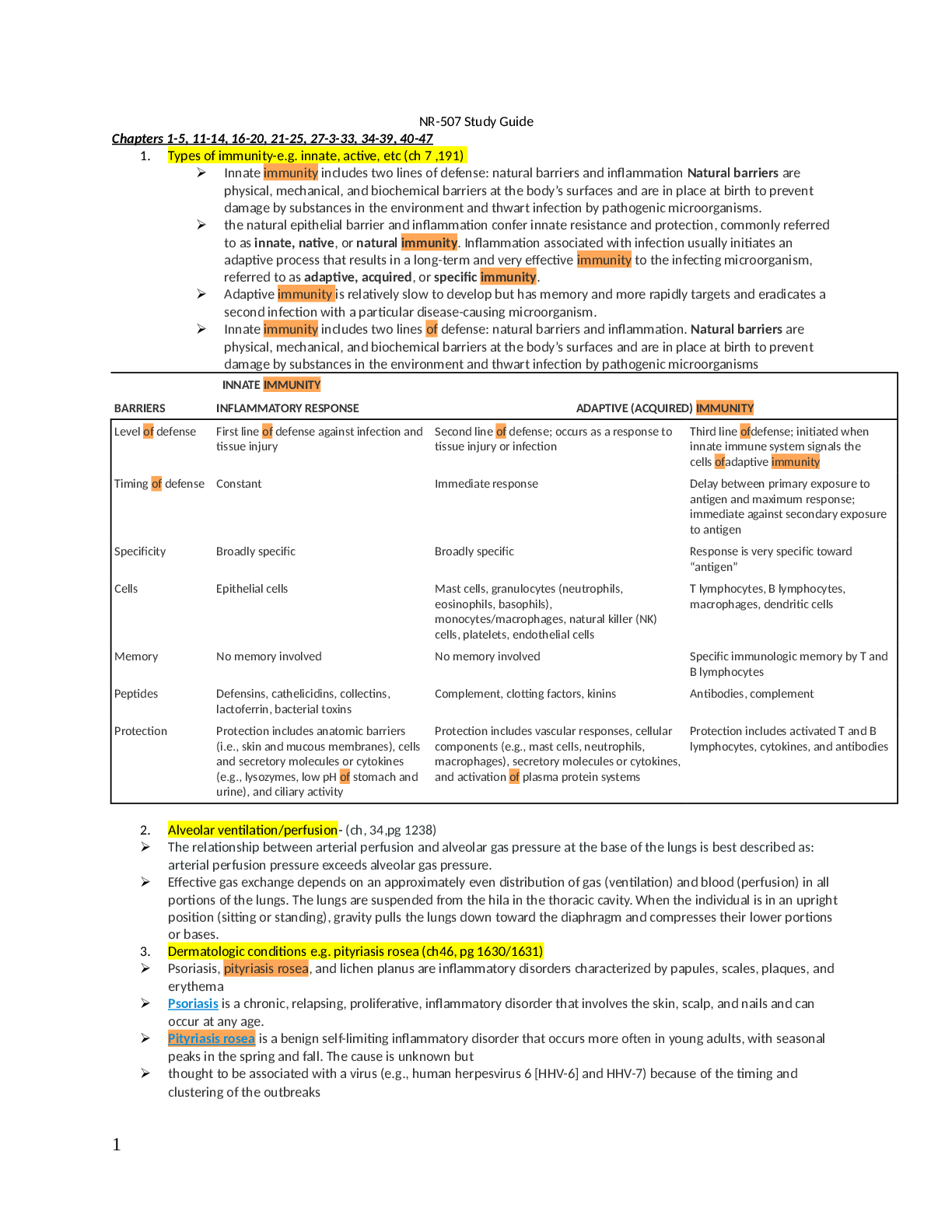


.png)
